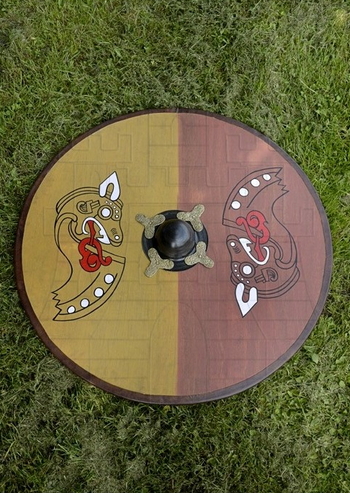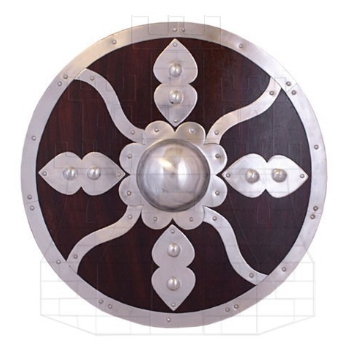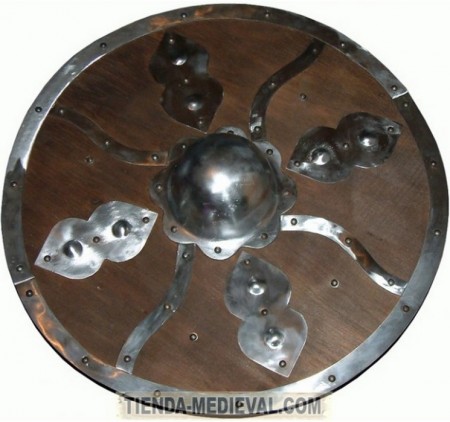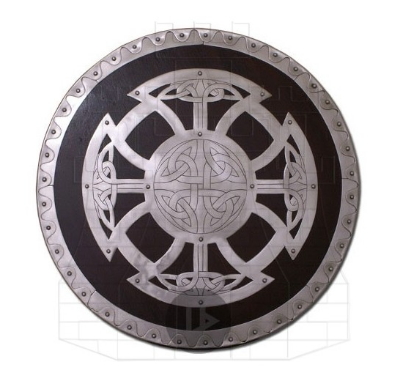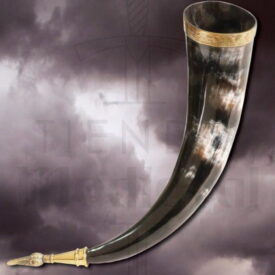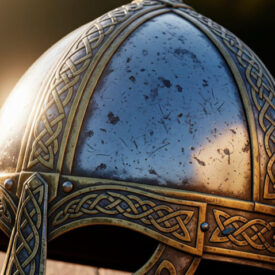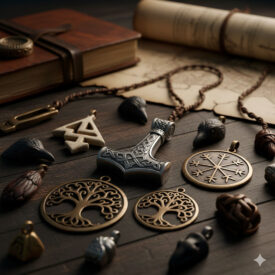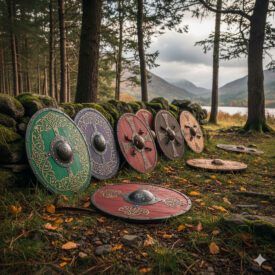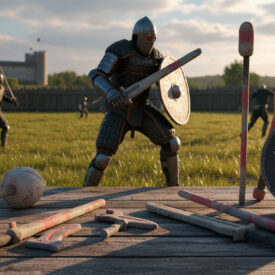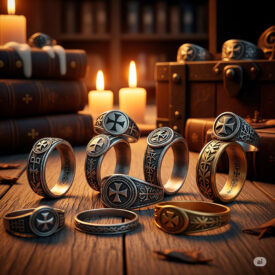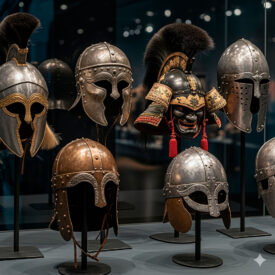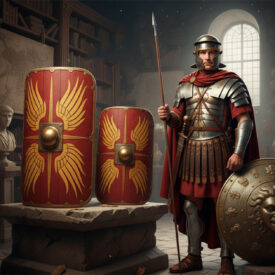When we think of a Viking warrior, one of the first images that comes to mind is that of a strong man with an axe and, of course, a round shield. Indeed, in an era where armor and helmets were a luxury for a few, the shield stood as the primary defense and an essential tool in the arsenal of these intrepid Norsemen. But were Viking shields simple pieces of wood, or was there something more to their design, use, and meaning? Let’s find out!
A Look Back: The History of the Skjöld and Its Variants
The Viking shield, known as skjöld in Old Norse, was not a common round shield like those seen later in the European Middle Ages. Its particular design and construction made it unique. Although today we tend to think of only one type, archaeology and historical records show us that there were mainly two designs that evolved with time and the needs of combat.
The Round Shield (Skjöld): The Icon of the Viking Age
This was the most widespread and emblematic type of shield from the beginning of the Viking Age, approximately in the 8th century, well into the 10th century. It usually had a diameter ranging from 60 to 90 centimeters, although examples as small as 45 cm or as large as 120 cm have been found. It is probable that many of these shields were custom-made for the warrior who would carry them, adapting to their physique and fighting style. Its lightness and thinness made it ideal for the tactic of the famous shield wall, a defensive and offensive formation that became synonymous with Viking ferocity in battle.
Much of what we know today about these shields comes from archaeological finds. One of the most significant is the grave goods from the Gokstad ship in Norway, where numerous shields were found. Interestingly, the shields found in Gokstad measured over 90 cm, leading some historians to speculate that these larger sizes might have been used for the defense of the sides of ships, rather than for direct ground combat. This has fueled the belief that actual combat shields were smaller, perhaps no more than 70 cm in diameter, to facilitate maneuverability in the fray. However, recent discoveries, such as those from a Viking cemetery in Dysnes, Iceland, have revealed over 100 objects, including three shields, two swords, and three spears, suggesting the importance of these objects in high-status 10th-century burials and providing more data on their dimensions and construction.
The Kite or Tear-shaped Shield: An Evolution in Protection
It emerged as a natural evolution of warfare needs between the 10th and 13th centuries, marking a change in combat tactics. Its inverted tear shape offered significantly greater protection than the round shield, as it covered not only the warrior’s torso but also extended downwards to protect the legs. It was generally heavier and more resistant than its round predecessor, and featured a more reliable fastening system, often with straps that allowed it to be secured to the arm, making it more suitable for individual use and less dependent on the shield wall formation.
What the Viking Shield Was Like in its Essence
The Viking shield, in its most common design, was lightweight, appropriately sized to cover the torso, and had a gripping system that allowed for better handling. This combination of lightness and maneuverability made it a formidable tool for both defense and quick attack in the heat of battle. Its design allowed warriors to move with agility, deflecting blows and creating openings for their own offensives.
Norse Engineering: Construction and Materials of the Skjöld
The Vikings were master craftsmen, and their shields are an eloquent testament to their ingenuity and pragmatism. The manufacture of a skjöld required great skill and a deep knowledge of the materials available in their environment, carefully selecting each component to maximize strength, durability, and lightness.
Key Materials in Viking Shield Manufacturing
The choice of materials was crucial for the shield’s effectiveness in combat:
- Wood: It was, without a doubt, the main material and the heart of the shield. Woods such as lime (known as lind in scaldic poetry), fir, pine, oak, alder, and poplar were primarily used. Lime was especially preferred for its lightness and flexibility, properties that allowed the shield to better absorb impacts without breaking. On the other hand, oak offered greater hardness and durability, albeit at the expense of greater weight. The wood was carefully worked to form the base of the shield.
- Leather: Fundamental for the shield’s strength and durability. It was used to cover the wooden surface, protecting it from direct blows, moisture, and crucially, preventing it from splitting in the heat of battle. A fragment found in Birka, an important Viking settlement, even shows sheepskin leather tanned on both sides and a thick cowhide edge, which underlines the sophistication in the use of this material. Leather, meticulously treated, was the “plastic” of the era, capable of deflecting and diverting blows with surprising effectiveness.
- Metal (Iron and Bronze): Although metal was not the main material of the shield body, it was crucial for reinforcements and the warrior’s protection.
- Umbo (Boss): A central metal dome, generally made of iron, that protected the warrior’s hand from direct blows. It had a diameter of about 15 cm and a thickness of between 3 and 5 mm, with an ovoid section designed to efficiently deflect blows. It was attached to the shield with iron rivets, providing a secure grip point and vital hand defense.
- Rings and Reinforcements: The shield’s perimeter was often reinforced with metal or leather rings, which prevented the edges from tearing and increased overall strength. Sometimes, staples or “heels” were attached to the perimeter for greater resistance against bladed blows. Transverse iron or bronze plates could also be added to the back to reinforce the union of the wooden staves, providing additional structural cohesion.
Essential Parts of the Viking Shield
Viking warriors used large wooden round shields, which were gripped from behind an iron umbo or boss. This feature is one of the main reasons why the Viking shield is associated with a predominantly round shape, as the central umbo is characteristic of this design.
On the front, generally, the shield could have three iron bands crossing the surface to add reinforcement and protection against sword or axe blows. A robust handle, fixed to the back by iron nails, allowed the warrior a firm grip and control over the shield, facilitating its manipulation in combat.
Manufacturing Process and Intelligent Design
Round shields were constructed by joining several wooden staves (normally 7 or 8) with some type of resinous glue, sometimes caulked to ensure solid and durable joints. One of the most curious and functional characteristics of their construction was that the thickness of the staves was not uniform; they were thicker in the center (approximately 1 cm) and thinned towards the edges (about 5-6 mm). This construction gave the shield a slightly curved surface, similar to a lens, which not only made it light but also flexible, allowing it to yield without breaking and better absorb the energy of blows, deflecting them instead of absorbing them head-on.
The shield was held solely by a central handle, without arm attachments or a neck strap. This gripping system, though seemingly simple, gave the warrior a remarkable range of motion and greater maneuverability, allowing quick reactions in combat. Occasionally, a strap was used to hang it on the back when not in use, facilitating transport.
Size and Proportion: The Key to Viking Shield Effectiveness
The size of Viking shields was adjusted to the warrior’s body size and, crucially, to their fighting style. A shield needs to be large enough to provide the desired protection, but no larger than necessary. This balance was vital for effectiveness on the battlefield.
A shield that is too small exposes additional lines of attack that an opponent can exploit, leaving the warrior vulnerable. Conversely, a shield that is too large slows down defensive responses, making the wielder slower and less agile, and unnecessarily exhausts the fighter, compromising their stamina in prolonged combat. The appropriate proportion was, therefore, a determining factor for survival and success in battle.
On the Battlefield: Practical Use and Viking Tactics with the Shield
The Viking shield was an extraordinarily versatile tool in combat, used for both defense and attack. It served not only to deflect and push enemy attacks, but also to immobilize the opponent’s weapons or even to strike directly, taking advantage of its edge and robustness. Its lightness and unique gripping system offered great maneuverability, but it was not designed for extended individual use in isolation, but primarily for tactical formations that maximized its defensive and offensive potential.
The Shield Wall (Skjaldborg): Fortress and Offense
The most famous and effective Viking tactic was the Shield Wall, known as Skjaldborg. This formation, similar to the Greek phalanx or the Roman testudo, was adapted and perfected by the Vikings from the practices of Germanic warriors. It consisted of a dense formation, sometimes up to five rows deep, where the warriors in the front line stood shoulder to shoulder, overlapping their shields. This created an almost impenetrable barrier that offered excellent protection against projectiles such as arrows and spears, as well as against the initial assaults of enemy infantry.
Although at first glance it seemed a purely defensive maneuver, the skjaldborg was also a very powerful offensive formation. After absorbing the enemy’s initial charge, the Vikings used their own shields to push enemy forces, seeking to disorganize their ranks. At the same time, they slightly loosened their own formation to gain the elbow room needed for their vigorous attacks with axes, swords, and other weapons. The back rows supported with long spears that protruded over and between the shields of the front line, creating a “hedgehog formation” that was very difficult to penetrate. When surrounded or outnumbered, they adopted a circular formation (ring), joining shields to create a defensive wall in all directions, a tactic that allowed them to withstand sieges and counterattacks from multiple flanks. This formation is attested in medieval chronicles of battles such as Brunanburh, Ashdown, Marton, and Corbridge, demonstrating its prevalence and effectiveness in the conflicts of the era.
The Shield Wall Debate: Tactic or Poetry?
It is important to mention that there is a debate among archaeologists and historians about the actual application of this tactic. Recent research, such as that by Rolf Warming of the Society for Combat Archaeology, suggests that the popular image of a static shield wall might be a misunderstanding or an idealization. His experiments with authentic replicas have shown that Viking shields could be too weak to withstand constant blows in a passive, static formation, suffering more damage than when actively used to deflect, strike, or move. Warming believes that the phrase “shield wall” might have been more a poetic term to describe the deployment of warriors in a dense line than a rigid, unmoving tactic. He proposes that Vikings likely fought in looser formations, using their shields circularly to intercept weapons or strike with the edges, which would allow them greater fluidity and adaptability in hand-to-hand combat. However, other experts, such as Anne-Christine Larsen of the Trelleborg Viking fortress, insist on the need for large-scale tests with complete armies to fully validate this theory and understand the true dynamics of these formations.
Another notable tactic in the Viking arsenal was the svinfylking, a wedge formation with which warriors attempted to break through enemy lines, disrupting their cohesion and sowing chaos in their ranks.
Beyond Function: Symbols and Social Significance of the Viking Shield
Viking shields were much more than simple tools of war; they were powerful symbols of status, honor, and identity. Their design and decoration reflected not only the values and beliefs of Norse society but also the social position and affiliations of the bearer. Each shield was, in a way, an extension of the person who wielded it, a canvas where the Viking worldview was embodied.
Decoration and Symbolism on Viking Shields
The decoration of Viking shields was rich in meaning and varied in its motifs:
- Vivid Colors: They were usually painted with striking and contrasting colors such as red, white, black, and yellow. It is believed that the colors could indicate the intentions of the ship’s occupants: red and black for war and aggression, while white might have symbolized peace or the intention to trade. It is also thought that red was associated with blood and battle, and white with purity and honor, fundamental elements in the Viking warrior mentality.
- Patterns and Motifs:
- Spirals, Triskelions, and Swastikas: These were common motifs, often distributed in quadrants on the shield’s surface. Spirals, in particular, influenced later medieval heraldry.
- Stylized Animals: Figures of dragons, wolves, eagles, and ravens were frequent and laden with symbolism. Ravens, in particular, represented Odin, the main god of the Norse pantheon, and were associated with wisdom, intelligence, and glory in battle, due to his two ravens Hugin (thought) and Munin (memory) who brought him information from the world. Wolves could symbolize both the best of the Viking warrior nature (teamwork, bravery, ferocity) and the worst (uncontrollable fury, destructive power). Dragons, for their part, symbolized greatness, strength, danger, and the pursuit of wealth.
- Runic Motifs: Runes, the ancient Norse alphabet, were engraved on the shields. It was believed that they possessed magical powers to offer protection to the warrior, strengthen their courage in combat, and ensure victory against enemies.
- Mythological Symbols: The Valknut (Odin’s knot), composed of three intertwined triangles, was a symbol directly associated with Odin and linked to fallen heroes in battle, those destined for Valhalla. It was also interpreted as a representation of the nine worlds of the Norse universe and the cycle of life and death.
- Purpose: These decorations were not just aesthetic; they aimed to intimidate the enemy before and during combat, and at the same time, strengthen the cohesion and pride of the warriors themselves, instilling in them a sense of shared identity and purpose.
The Decoration of Viking Shields: Art and Message
Some Viking shields show evidence of paint (mineral pigments ground in an oil base) on the wood surface, as a decorative element. The round Viking shield was also often decorated with hand-painted Norse mythology scenes, narrating stories of gods, heroes, and mythical creatures, which added another layer of meaning and power to the object.
The Shield in Daily Life and Ritual
In addition to their martial function, shields held a special place in the daily and ceremonial lives of the Vikings. They were hung on the gunwales of the drakkars (Viking ships) not only as a display of power and wealth but also to protect the crew from waves and wind during voyages. On land, they were displayed on the walls of longhouses (Viking communal houses) as decorations, symbols of the family’s warrior prowess and trophies from past battles. They could even serve as improvised stretchers to transport the wounded from the battlefield, demonstrating their multifaceted utility. They were also used in ritual ceremonies and, as archaeological finds attest, were a fundamental part of grave goods, accompanying warriors on their final journey to the afterlife.
The Decline of the Round Skjöld and the Legacy of the Viking Shield
Towards the 11th century, the iconic round shield began to fall into disuse, giving way to the kite shield. Although the round shield was versatile and allowed offensive maneuvers such as edge blows or being thrown to escape if it broke, its single gripping point made it vulnerable to being deflected or even torn away by an axe blow or a powerful sword strike. This vulnerability, coupled with the evolution of combat tactics towards a more individualized approach and the need for greater body protection, drove the evolution towards shields with more reliable fastenings and shapes that offered more extensive coverage, better suited for individual combat and the new tactical formations emerging in medieval Europe.
Even so, the Viking shield, with its intelligent construction, its vital role in battle tactics like the skjaldborg, and its profound cultural significance, remains an enduring symbol of the Viking Age. It reflects the adaptability, ingenuity, and indomitable spirit of these Norse warriors, whose history and legacy continue to fascinate. If you are passionate about Viking history and wish to own an authentic replica of these impressive pieces of history.
We invite you to explore our wide selection of Viking shields and other historical shields at Medieval Shop, where legend comes to life in every detail. Discover the craftsmanship and symbolism that made these shields much more than a simple defense.
View all Viking Shields
View more Historical Shields
